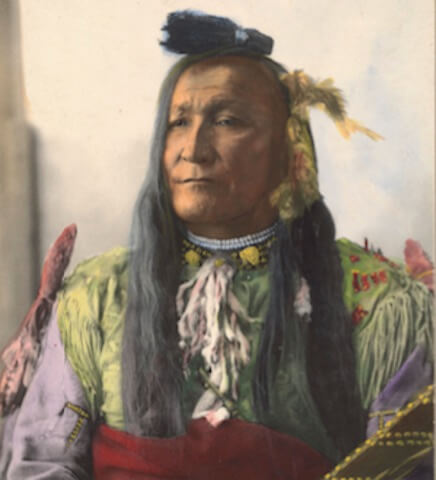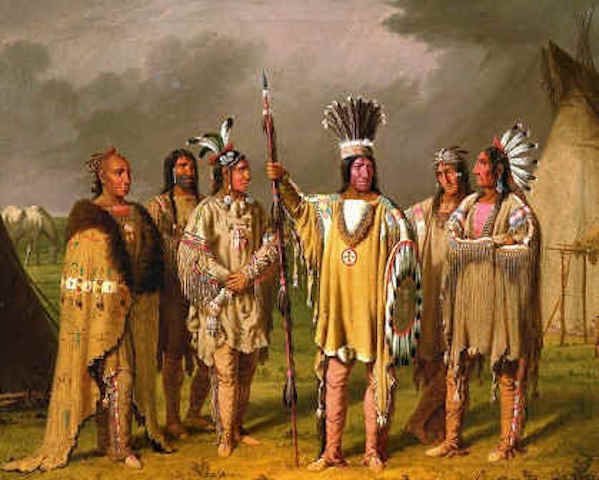The Blackfoot Indians of the United States and Canada are
divided into three main groups: the Northern Blackfoot or
Siksika, the Kainah or Blood, and the Piegan. The three as a
whole are also referred to as the Siksika (translated
Blackfoot), a term which probably derived from the
discoloration of moccasins with ashes. The three groups
constitute what are apparently geographical-linguistic groups.
All three speak a language which is a part of the Algonquian
family. The Piegan and Blood are the most closely related
dialects.
Before the Blackfoot were placed on reservations in the
latter half of the nineteenth century, they occupied a large
territory which stretched from the North Saskatchewan River in
Canada to the Missouri River in Montana, and from long. 105
degrees West to the base of the Rocky Mountains. The Piegan
were located toward the western part of this territory, in the
mountainous country. The Blood were located to the northeast
of the Piegan, and the Northern Blackfoot were northeast of
the Blood.
The Blackfoot were placed on four reservations. The Blackfeet
Agency, the Blood Agency, and the Piegan Agency are all
located in Alberta, Canada. The Blackfeet Reservation
in Montana is inhabited by Piegans. (References to Northern
Piegan indicate the Canadian Piegan, while references to the
Southern Piegan indicate the Montana Piegan.) (Blackfoot is
the correct name - white man thought it should be 'plural' and
changed to Blackfeet)
The Blackfoot are typical of the Plains Indians in many
aspects of their culture. They were/are nomadic
hunter-gatherers, who live in tipis. They once subsisted
mainly on buffalo and large mammals and, in addition, gathered
a lot of vegetable foods. Traditions indicate that the buffalo
were/are hunted in drives, although hunting patterns changed
when horses and guns were introduced. Deer and smaller game
were/are caught with snares. Fish, although abundant, were
eaten only in times of dire necessity and after the
disappearance of the buffalo.
During the summer, the Blackfoot lived in large tribal
camps. It was during this season that they conducted Buffalo
Hunts in times gone by, and the Sun Dance ceremonies are held
in summer. During the winter, they separated into bands of
from approximately 10 to 20 lodges. Band membership is quite
fluid. There might be several headmen in each band, and one of
them is considered the chief. Headmanship is very informal.
The qualifications for the office were once "wealth" and
success in war, as well as ceremonial experience.
The religious life of the Blackfoot centers upon medicine
bundles and their associated rituals. These bundles are
individually owned and ultimately originated from an encounter
with a supernatural spirit. These encounters take the form of
dreams or visions, which are sought in a typical Plains type
of vision quest. A young man, usually under the tutelage of an
older medicine man, goes out to an isolated place and prays
and fasts until he has a vision. Many of these men fail and
never have a vision.
Individual bundles acquire great respect. Some of these are
headdresses, shirts, shields, knives, and "medicine objects".
Painted lodges are considered to be medicine bundles, and
there are more than 50 of them among the three main Blackfoot
groups. The most important bundles to the group as a whole are
the Beaver Bundles, the Medicine Pipe Bundles, and the Sun
Dance Bundle.
The Sun Dance among the Blackfoot is generally similar to
the ceremony that is performed in other Plains societies.
There are some differences, in that a woman plays the leading
role among the Blackfoot, and the symbolism and paraphernalia
used are derived from beaver bundle ceremonialism. The
Blackfoot Sun Dance includes the following: (1) moving the
camp on four successive days; (2) on the fifth day, building
the medicine lodge, transferring bundles to the medicine
woman, and the offering of gifts by children and adults in ill
health; (3) on the sixth day, dancing toward the sun, blowing
eagle-bone whistles, and self-torture; and (4) on the
remaining four days, performing various ceremonies of the
men's societies.
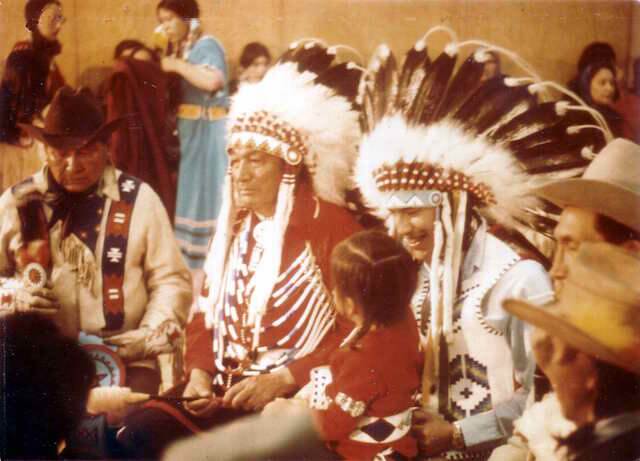
Adventures
of Bull Turns Round
Adventures of Old Man
Coyote
Bear-Moccasin, the
Great Medicine-Man
Beaver Meat
Beaver Medicine
Black and Yellow
Buffalo-Painted Lodges
Bear Woman
Blood-Clot-Boy
Broken
Promise
Buffalo-berry
Buffalo Rock
Camp
of the Ghosts
Chief Mountain
Contest Between the
Thunder-Bird and the Raven
Coyote
and the Rolling Rock
Creation Story
Crow Indian
Water-Medicine
Daily Life and Customs
Deeds and
Prophecies of Old Man
Dog-Chief
Earth Diver
Fed by a
Coyote
First Buffalo Stone
First
Marriage
Fish Dog Skin
Has-Scabs-All-Over
Heavy
Collar and the Ghost Woman
How a Piegan Warrior
Found the First Horses
How Medicine-Hat Got
Its Name
How men and women got
together
How the Blackfoot got the Buffalo Jump
(Piskun)
How
the Blackfoot Obtained the Spotted Horses
How the Ducks Got Their Fine Feathers
How the Man Found His
Mate
How
the Old Man Made People
How The Otter Skin
Became Great Medicine
How the Worm Pipe Came
to the Blackfoot
Iktomi
and the Turtle
Kip a ta ki (Old Woman)
Languages
Confused on a Mountain
Legend of the Beginning
Little
Friend Coyote
Making
of the Earth
Meal for Nata'Yowa
Old Man and the
Beginning of the World
Old
Man and the Great Spirit
Old Man and the Roasted
Squirrels
Old
Man Leads a Migration
Order
of Life and Death
Origin of the Sweat Lodge
Origins
of the Buffalo Dance
Pipe
From the Seven Stars
Piqued Buffalo-Wife
Sits
By The Door
Tracing Five Generations of a
Blackfoot Family
Water Spirit's Gift of Horses
Why
People Die Forever
Why the birch-tree
wears the slashes in its bark
Why the Chipmunk's Back
is Striped
Why The Curlew's Bill
is Long and Crooked
Why the Mountain Lion
is Long and Lean
Why the Nighthawk's
Wings are Beautiful
Wise Man of Chief Mountain
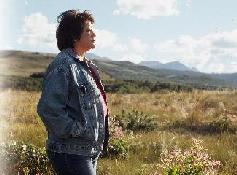
The Buffalo Dance - One of the primary sources of food and
other needs was the American Bison. The typical hunting method
was drive a herd off a cliff and butcher them after they died
at the bottom of the cliff. Similar methods were used in
ancient Europe.The night before, the shaman ceremonially
smokes tobacco and prays to the sun. His wives are not allowed
to leave their home, nor even look outside, until he returns;
they were to pray to the sun and continually burn sweet grass.
Fasting and dressed in a bison headdress, the shaman led a
group of people at the head of a V formation. He attracted the
herd's attention and brought them near the cliff; they were
then scared by other men hiding behind them, who waved their
robes and shouted. The bison ran off the cliff and died at the
rocks below.
According to legend, at one point the bison refused to go
over the cliff. A woman walking underneath the cliff saw a
herd right on the edge and pledged to marry one which jumped
down. One did so and survived, turning into many dead buffalo
at the bottom of the cliff. The woman's people ate the meat
and the young woman left with the buffalo. Her father went in
search of her. When he stopped to rest, he told a magpie to
search for his daughter and tell her where he was. The magpie
found the woman and told her where her father was located. The
woman met her father but refused to go home, frightened that
the bison would kill her and her father; she said to wait
until they were all asleep and would not miss her for some
time.
When she returned to the bison, her husband smelled another
person and, gathering his herd, found the father and trampled
him to death. The woman cried and her husband said that if she
could bring her father back to life, they could both return to
their tribe. The woman asked the magpie to find a piece of her
father's body; he found a piece of his spine.
The Piegan Blackfeet (Aapatohsipiikanii (Southern
Piik.ni/Peigan) or simply as Piik.ni in Blackfoot) are a tribe
of Native Americans of the Algonquian language family based in
Montana, having lived in this area since around 6,500 BC. Many
members of the tribe live as part of the Blackfeet Nation in
northwestern Montana, with population centered in Browning.
According to the 1990 US census, there are 32,234
Blackfeet.[1] Three other tribes of the Blackfoot Confederacy
are First Nations located in Alberta, Canada.
The Blackfeet
Reservation is located in Northwest Montana, just east
of Glacier National Park. The 1.5-million acre reservation
includes most of Glacier County and is home to about 7,500
members of the Blackfeet Nation, or about half of the total
enrollment of some 14,700 members. Those living away from the
reservation live mostly in the Pacific Northwest but some are
as far away as Europe.
The town of Browning is the hub of the reservation and the
home of several tribal offices and businesses. Other
communities include Babb, East Glacier Park and St. Mary. The
traveler will find a number of motels, hotels, campgrounds and
restaurants on the reservation along with plentiful
recreational opportunities there and within the nearby Glacier
National Park.
The Blackfoot language is also agglutinative. The Blackfoot
do not have well documented male Two-Spirits, but they do have
"manly-hearted women" (Lewis, 1941) who act in much of the
social roles of men, including willingness to sing alone,
usually considered "immodest", and using a men's singing
style. (Nettl, 1989).
The Blackfoot confederacy consists of the North Peigan
(Aapatohsipiikanii), the South Peigan (Aamsskaapipiikanii),
the Blood (Kainah), and the Siksika tribe ("Blackfoot") or
more correctly Siksikawa ("Blackfoot people"). Three of the
four are located in Alberta, Canada while one, the South
Peigan, is located in Montana. All together they traditionally
called themselves the Niitsitapii (the "Real People"). These
groups shared a common language and culture, had treaties of
mutual defense, and freely intermarried.
The Blackfoot were fiercely independent and very successful
warriors whose territory stretched from the North Saskatchewan
River along what is now Edmonton Alberta, Canada, to the
Missouri River of Montana, and from the Rocky Mountains and
along the Saskatchewan river and down into the state of
Montana to the Missouri river.
The basic social unit of the Blackfoot, above the family, was
the band, varying from about 10 to 30 lodges, about 80 to 240
people. This size group was large enough to defend against
attack and to undertake small communal hunts, but small enough
for flexibility. Each band consisted of a respected leader,
possibly his brothers and parents, and others who need not be
related. Since the band was defined by place of residence,
rather than by kinship, a person was free to leave one band
and join another, which tended to ameliorate leadership
disputes. As well, should a band fall upon hard times, its
members could split-up and join other bands. in practice,
bands were constantly forming and breaking-up. The system max
Blackfeet Indian
Stories by George Bird Grinnell
Blackfoot
Digital Library
Blackfoot Creation and
Origin Myths
Blackfoot Culture and
History
Blackfeet Indian
History
Constitution and
By-Laws For the Blackfeet Tribe
Blackfeet
Indian Legends, Myths, and Stories
Blackfeet Legends
Blackfoot
Myths and Legends
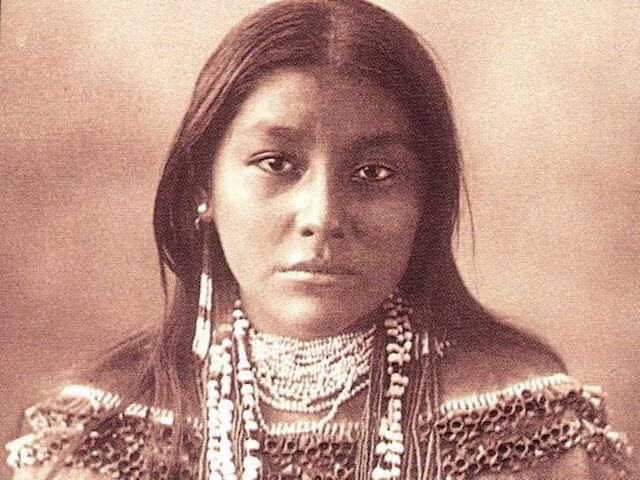
Blackfoot music, the music of the Blackfoot tribes, (best
translated in the Blackfoot language as nitsinixki - "I sing",
from ninixksini - "song") is primarily a vocal kind of music,
using few instruments (called ninixkiitsis, derived from the
word for song and associated primarily with European-American
instruments), only percussion and voice, and few words.
By far the most important percussion instruments are drums
(istokimatsis), with rattles (auani) and bells often being
associated with the objects, such as sticks or dancers legs,
they are attached to rather than as instruments of their own.
The basic musical unit is the song, and musicians, people who
sing and drum, are called singers or drummers with both words
being equivalent and referring to both activities. Women,
though increasingly equal participants, are not called singers
or drummers and it is considered somewhat inappropriate for
women to sing loudly or alone. Piskani - "dance" or "ceremony"
- often implicitly includes music and is often applied to
ceremonies with little dancing and much singing.
Blackfoot music is an "emblem of the heroic and the difficult
in Blackfoot life." This is evidenced by: "the separation of
music from the rest of life through aspects of performance
practice, a sharp distinction between singing and speaking,
the absence of words in many songs, and the use of song texts
to impart major points in myth in a condensed and concentrated
form all relate music to the heroic aspect of life. There is a
close association of music to warfare and the fact that most
singing was done by men and the musical role, even today, of
community leaders and principal carriers of tradition. The
acquisition of songs as associated with difficult
feats--learned in visions brought about through self-denial
and torture, required to be learned quickly, sung with the
expenditure of great energy, sung in a difficult vocal
style--all of this puts songs in the category of the heroic
and the difficult."
Official
Site of the Blackfeet Nation
Links
Spirit Talk Culture
Institute
P.O. Box 477
East Glacier, In the Blackfoot Nation 59434-0477
Phone: (406) 338-2882
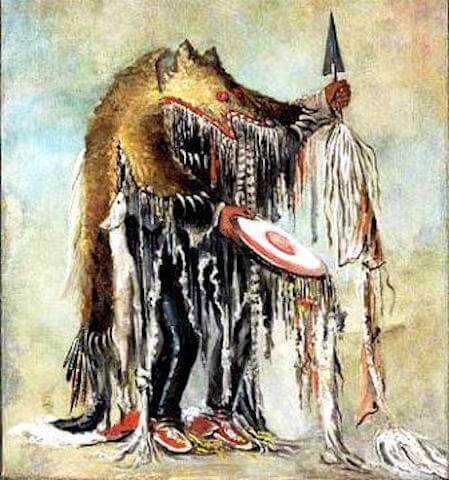
NIITSITAPII AHSISTO
(The Real People Declare)
"Believe in the beauty and strength of your own being. Forget
the foolish belief that you and your fellow human beings were
born evil. Those who would control you all the days of your
life on earth perpetuate the belief iihtsipaitapiiyopa (Source
of Life) made things to have a bad spirit.
Live a life of truth and honesty. This makes you a person of
quality and dignity. Truth and honesty are the kind of
leadership qualities that attracts others.
Give honor and respect to others regardless of age and
situation in life. This quality makes you and others worthy of
honor and respect, which makes others, feel worthwhile and
fulfilled. Honor and respect empowers others so they can win
the day. They will return it to you fourfold.
Honor the earth and all that exists. Be strong in this belief
and practice it throughout your life because it makes for a
world of kindness that binds all the good things of life
together in a circle of harmony.
Be humble but not timid. To be humble is to connect yourself
to the stars and the entire universe and makes you aware there
is something unique about life that is to be enjoyed without
fear. We are people from the stars and because of it we are
sacred.
Help others realize that life is a dream . . . . A beautiful
dream. Dreamers are the butterflies of life and help others to
realize their dreams.
Be humorous and help others to enjoy life and the life of
others. Humor makes you attractive. The humorous person has
many guests and the one who is invited everywhere because of
the joy they bring to the gathering.
Never be afraid to talk matters over with those you disagree
with or those you love. The gift of language is a miracle and
it is meant to be used to live a life of harmony, joy, love,
and respect. Use it well and use it often.
What is described here is leadership and happiness in the
broadest sense. These are the qualities that make for a great
father, grandmother, mother, teacher, grandfather, lover,
traditional leader, friend and a great human being. Best of
all you can add to this list."
I give these to you in honor and respect:
Long
Standing Bear
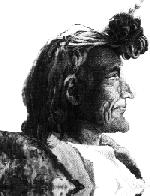
 Return to Indigenous Peoples' Literature
Return to Indigenous Peoples' Literature
Compiled by: Glenn
Welker
ghwelker@gmx.com
Copyright
@ 1993-2016
This site has been accessed 10,000,000 times since
February 8, 1996.
